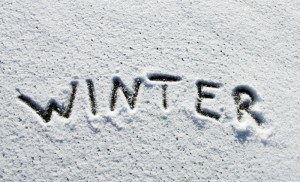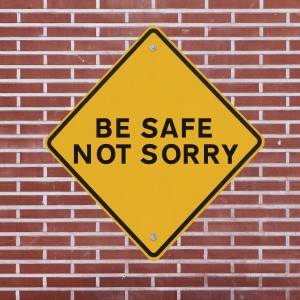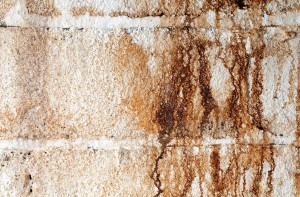As the temperatures drop outside, people come indoors to work, play, and spend time with friends and family. Oftentimes during the winter, this time is spent in front of a fireplace enjoying its warmth and ambiance. Unfortunately, what some homeowners fail to realize is that winter weather can have a negative impact on your chimney over time.

While winter means the coming of the festive holiday season, it also brings frigid temperatures, freezing rain, ice, and snow. Because the winter is typically the heaviest use season for fireplaces, it is important to have an annual sweep and inspection done as early as possible to ensure that your heating appliance is working efficiently, has not been damaged, and is safe to use all winter long.
How water damages chimneys
One of the most common – and most preventable – ways that chimneys are damaged is through long term exposure to moisture. Water can wreak havoc on a chimney and fireplace system, affecting everything from the bricks and mortar to the flue and damper.
While chimneys may appear to be simple structures, they are actually surprisingly complex. Because of this, finding the exact cause of water entry may be difficult. Here are two common ways that water enters a chimney.
Chimney cap: A chimney cap, sometimes known as a rain guard, covers the top portion of the chimney. This allows smoke out while keeping sparks and embers in. If damaged, water, debris, and even animals can get into the chimney.
Masonry damage: The bricks and mortar of a chimney are constantly exposed to the elements. Because of this, absorbed water constantly freezes and thaws, creating cracks that allow more water to enter. Over time, the freeze-thaw process can cause major damage to the chimney as bricks crack and crumble.
Preventing water damage
Although it is inevitable that chimneys are exposed to water from rain, ice, and snow, there are steps that homeowners can take to prevent and minimize water damage. Preventative maintenance is the most effective way of preventing water damage. During an annual sweep and inspection, a trained technician will inspect the chimney for any signs of damage to the masonry, chimney cap, or other parts of the chimney. When spotted early, many minor problems can be fixed before they turn into major concerns, saving both time and money.
In addition, the trained technicians at Jack Pixley Sweeps can apply a variety of protective sealants to existing masonry structures to prevent water from seeping in. These professional grade products can provide as much as ten times the water prevention of standard brands. These sealants can greatly extend the life of your chimney and prevent any existing damage from getting worse.
Animal entry
Just as people tend to stay inside more during the winter, birds and other small mammals seek shelter as the temperatures turn cold. Because of this, uncapped chimneys or those with un-repaired openings often become hiding places for wildlife. In order to continue safely using your fireplace, it is important to have the animals safely removed as quickly as possible. Following removal, repairs can be made to make sure the animals cannot reenter the chimney structure.
If you have questions about preparing your chimney for winter, contact the experts at Jack Pixley Sweeps today!

Use only a certified chimney sweep like Jack Pixley Sweeps to work on your chimney system
Fireplaces are an important part of our homes. In addition to serving a decorative or aesthetic purpose, they add value to a house and can serve as a reliable heat source during cold winter months. Despite the importance of proper fireplace and chimney maintenance, many homeowners neglect to complete necessary annual cleanings or attempt to do it themselves.
While DIY projects are a great way to save money on many household projects, cleaning a chimney system is not a project that should be undertaken by the average weekend warrior. By hiring a certified professional, homeowners can guarantee that their chimneys and fireplaces will last for years to come.
Why use a certified chimney sweep?
Just as you would not go to a dentist for a broken leg, it is not recommended to hire a regular renovation company to clean, update, or repair a broken fireplace or chimney. Hiring a certified chimney sweep ensures that the person servicing your chimney system is a trained professional who is up to date with the latest technology, standards, and techniques in the industry.
Most reputable companies will have chimney sweeps certified by the Chimney Safety Institute of America, or CSIA. With over 1,400 CSIA certified chimney sweeps in North America, it is easy to locate one of these highly trained professionals to service your chimney system. The technicians from Jack Pixley Sweeps are certified by both the CSIA and the National Chimney Sweep Guild.
What can I expect from a certified chimney sweep?
CSIA certified chimney sweeps are held to a higher level of knowledge and professionalism than others working in the industry. Because of this, you can expect your chimney sweep to be knowledgeable about the most recent advancements in chimney, fireplace, and venting safety along with the local building codes and manufacturer’s instructions for newly installed appliances.
Certified chimney sweeps should also act in a professional manner, including taking the time to explain how the cleaning process works, answering any questions you may have, and ensuring that furniture, carpets, and any other home décor is properly protected before beginning. Sweeps will evaluate both the interior and exterior of your chimney system, employing tools like the traditional chimney brush along with more modern technology such as vacuums, cameras, and other electronics.
Why is an annual inspection important?
An annual chimney inspection or cleaning is a chore that many homeowners tend to put off or ignore. Because of this, many small problems that could be easily and inexpensively fixed are not found until they become much bigger, more expensive, and more labor intensive problems.
“A chimney inspection is like an annual dental check-up,” says Ashley Eldridge, Director of Education for the CSIA. “It’s preventative maintenance that helps minimize potential hazards.” Additionally, the National Fire Protection Association Standard 211 says, “Chimneys, fireplaces, and vents shall be inspected at least once a year for soundness, freedom from deposits, and correct clearances. Cleaning, maintenance, and repairs shall be done if necessary.”
A certified chimney sweep will be able to not only clean and maintain your fireplace system, but will also be able to identify any areas in need of repair or those that many deteriorate in the future. Sweeps are also able to diagnose the causes behind common issues such as drafty chimneys, water leakage, or animal entry.

Contact us to learn more about how to protect your home’s masonry
Proper chimney care is something that’s often neglected by a lot of homeowners. What they don’t realize is the importance and benefits that a properly maintained chimney can bring to your home. In our many years of experience here at Jack Pixley Sweeps, we’ve been asked more times than we can count about the effects water can have on one’s chimney. So here’s a short guide that might be really helpful.
Water is your chimney’s enemy
According to the Chimney Safety Institute of America, water damage is the number one most common cause of majority of the reported chimney damages. Direct contact with water or even minor water penetration can increase the likeliness of damaging one or several of the materials in your chimney (i.e. metal, brick, stone, cast iron etc.).
The following are examples of the damage in your chimney and home’s interior and exterior structures caused by water penetration:
- Water stains in the ceiling and wall
- Rusting of the damper assemblies
- Decaying of the exterior mortar
- Cracked or damaged flue lining system
Water damage: Classified
There are three significant types of water damage that may occur in your home. Identifying which of the three is important in repairing and preventing the recurrence of the same damage.
Spalling – this type of water damage refers to the chipping, flaking or crumbling of your masonry chimney as a result of water penetration or contact. Your chimney would show flaking on the surface of the bricks and chimney crown. This is usually caused by the freeze/thaw cycle of water wherein the moisture present in the chimney area would freeze when there is a significant drop in temperature, and would begin to thaw again once temperature starts to go up.
Rust or Corrosion – this usually affects the metal parts and materials used for your chimney (such as the chimney flashing and cap). This is the first thing that chimney experts look for during an inspection because this is one of the most common water damage out there.
Mortar Joint Damage – this part of your chimney is highly susceptible to cracking. Because of this, it is also one of the common places to absorb moisture. Moisture content with the ideal environmental conditions can be a breeding ground for molds which would pose a health risk to you and your family.
What are you still waiting for? Now that you know the damages that water may cause, you should give Jack Pixley Sweeps a call and have your home and chimney checked before it’s too late.

Chimney mold can cause serious respiratory problems as well as other health concerns. Watching for telltale signs of a chimney leak can help you prevent mold from happening.
Do you know why molds are growing in your chimney? Are you curious as to why it poses a risk to your health and your home? We from Jack Pixley Sweeps would like to give you an overview based on the EPA guide on what mold really is and how it can affect your home.
General Description
When water leaks into your chimney, it creates a lot of problems involving the structure of your chimney and your house in general, and more importantly, your health. One very common result of water inside the chimney is the growth of mold. Usually, molds need moisture to reproduce and thrive. You can find mold spores on leaf debris as well as the damp environment of your chimney. They come in all sorts of colors like green, brown and black. It can have a distinct dank smell to it, too.
The most common cause of mold is water but they can come from different areas and situations, too. When there is water in damp areas, it should be cleaned within 24-48 hours to prevent creating the perfect environment for mold to flourish in.
How can you tell if you have been affected by mold?
You will know when mold is already starting to invade your homes when you notice you or any of the members of your family manifesting these things:
- Allergic reactions
- Nasal congestion
- Headache
- Cough and colds
- Eye irritation
- Infections in the throat or skin
If you see or feel any of the above mentioned symptoms, consult your doctor and have it treated as soon as possible. Don’t wait for your condition to become more serious.
How to prevent mold from forming?
One of many tips our CSIA-certified professionals will give you is to have your chimney inspected and cleaned annually. If you have a dehumidifier then this will make our job a lot easier because you can control the humidity inside the home and in areas prone to mold growth. Also, if you don’t have one yet, consider having a chimney cap installed to prevent water from coming in. You also need to waterproof your chimney with a waterproofing sealant and make sure your flue liner is intact.
The most important thing to do to prevent mold growth is ensuring that your chimney is properly cared for and maintained. Give us a call and we can tell you more about mold and how we can get rid of it. We guarantee that our services are worth your time and money. We have been serving almost 100,000 satisfied customers in the greater Minneapolis area for 35 years now. Our name is definitely something you can trust!

By ensuring proper care and maintenance for your chimney, you are adding more years to its life and increasing its functionality.
In chimneys as in life, it’s always worth thinking and talking about the future, and making sure you’re doing everything you can to ensure health, longevity and happiness. Your chimney is an important part of your home — it’s working hard, every time you have a fire, to carry dangerous gases and byproducts up and out of your living area, and protecting the building materials around your fireplace or stove from the high heat produced by that fire. A chimney can also be an expensive thing to tear down and rebuild, so focusing energy on protecting and preserving it is always a good call.
Wondering what you can and should do to extend the life of your chimney? Jack Pixley Sweeps techs are always glad to help our clients avoid headaches and get the most enjoyment possible out of their heating system.
Don’t Skimp On Regular Maintenance
We say it all the time: The best thing you can do for your chimney system (and your long-term and short-term enjoyment of it) is to diligently keep up with regular maintenance.
Annual chimney inspections are important — not only are Jack Pixley technicians able to make sure that your system is venting properly and doing its job effectively, but we’re also able to catch small problems early and make the proper repairs, before those small problems become large, potentially destructive issues.
Regular chimney sweeping is just as important. Creosote and other deposits build up in your flue as you use your appliance, and a dirty chimney can lead to a mix of short-term and long-term problems. Heavy creosote can block your flue and inhibit your chimney’s ability to vent, allowing dangerous gases to enter your living area. It can also lead to a chimney fire that severely damages your flue liner, even your chimney (or in the worst cases, your home) itself. Acidic deposits can also wear at your flue liner over time, leading to worn joints, cracks and gaps.
One of the key things we’ve learned over more than three decades of servicing chimneys in the greater Twin City area: Keeping up with those regular maintenance appointments will make a big difference in the longevity of your chimney.
Be Diligent About Moisture Intrusion
Your chimney system was designed with built-in protection against water intrusion. Your chimney crown is there to divert rain and snow away from the flue. Your flashing is there to keep water from getting into the joints where your chimney and roofline meet. Your chimney cap is there, in part, to help protect your flue opening from moisture intrusion too. Keeping an eye on all of those key areas of protection is worthwhile.
Jack Pixley technicians will always check those components during your annual chimney inspection, but in between inspections, if you notice an issue — a chimney cap that’s come off in a storm, or a part of your flashing that’s pulled up — give us a call. Repairing those issues quickly is important, since chimney leaks can quickly lead to considerable damage.
If you want to be particularly proactive in protecting your chimney system against moisture intrusion and damage, we recommend having us apply masonry water repellant, which helps your masonry deflect water and can significantly lengthen its service life.
Use Smart Burning Practices
A really important thing to always keep in mind: The right fuel for your wood-burning fireplace or stove is seasoned or kiln-dried cordwood, and only that. Burning green or moist wood can create immediate and long-term problems, from increased smoke and staining now to the development of dangerous Third Stage Creosote down the line (which is extremely combustible and extremely difficult to remove). Burning trash, treated wood or plastics can allow toxic gases into your living area, too.
Stick to the right fuel, and it’ll help you enjoy your fires now, and keep your chimney healthier in the long run.
Do you have any questions about how to best care for your chimney system? We’re always glad to help. Give Jack Pixley Sweeps a call!





